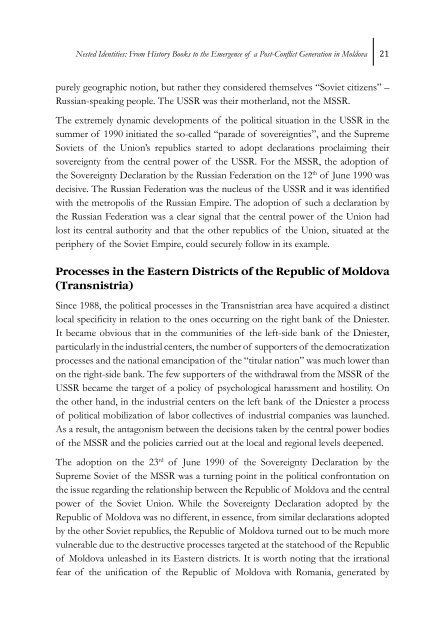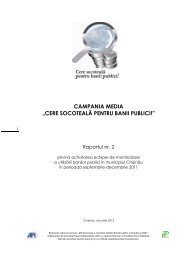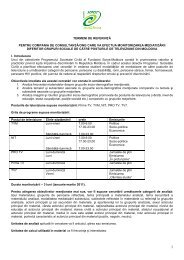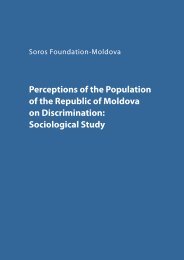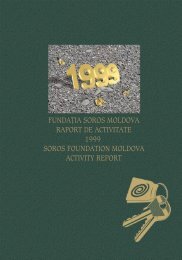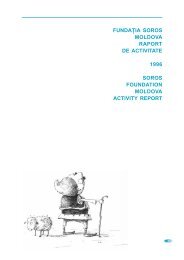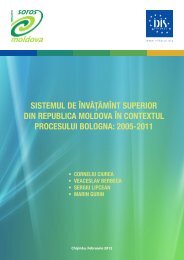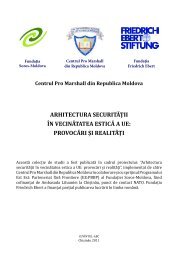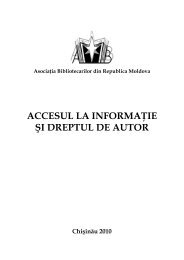Managing Intractable Conflicts: Lessons from Moldova and Cyprus
Managing Intractable Conflicts: Lessons from Moldova and Cyprus
Managing Intractable Conflicts: Lessons from Moldova and Cyprus
Create successful ePaper yourself
Turn your PDF publications into a flip-book with our unique Google optimized e-Paper software.
Nested Identities: From History Books to the Emergence of a Post-Conflict Generation in <strong>Moldova</strong><br />
21<br />
purely geographic notion, but rather they considered themselves “Soviet citizens” –<br />
Russian-speaking people. The USSR was their motherl<strong>and</strong>, not the MSSR.<br />
The extremely dynamic developments of the political situation in the USSR in the<br />
summer of 1990 initiated the so-called “parade of sovereignties”, <strong>and</strong> the Supreme<br />
Soviets of the Union’s republics started to adopt declarations proclaiming their<br />
sovereignty <strong>from</strong> the central power of the USSR. For the MSSR, the adoption of<br />
the Sovereignty Declaration by the Russian Federation on the 12 th of June 1990 was<br />
decisive. The Russian Federation was the nucleus of the USSR <strong>and</strong> it was identified<br />
with the metropolis of the Russian Empire. The adoption of such a declaration by<br />
the Russian Federation was a clear signal that the central power of the Union had<br />
lost its central authority <strong>and</strong> that the other republics of the Union, situated at the<br />
periphery of the Soviet Empire, could securely follow in its example.<br />
Processes in the Eastern Districts of the Republic of <strong>Moldova</strong><br />
(Transnistria)<br />
Since 1988, the political processes in the Transnistrian area have acquired a distinct<br />
local specificity in relation to the ones occurring on the right bank of the Dniester.<br />
It became obvious that in the communities of the left-side bank of the Dniester,<br />
particularly in the industrial centers, the number of supporters of the democratization<br />
processes <strong>and</strong> the national emancipation of the “titular nation” was much lower than<br />
on the right-side bank. The few supporters of the withdrawal <strong>from</strong> the MSSR of the<br />
USSR became the target of a policy of psychological harassment <strong>and</strong> hostility. On<br />
the other h<strong>and</strong>, in the industrial centers on the left bank of the Dniester a process<br />
of political mobilization of labor collectives of industrial companies was launched.<br />
As a result, the antagonism between the decisions taken by the central power bodies<br />
of the MSSR <strong>and</strong> the policies carried out at the local <strong>and</strong> regional levels deepened.<br />
The adoption on the 23 rd of June 1990 of the Sovereignty Declaration by the<br />
Supreme Soviet of the MSSR was a turning point in the political confrontation on<br />
the issue regarding the relationship between the Republic of <strong>Moldova</strong> <strong>and</strong> the central<br />
power of the Soviet Union. While the Sovereignty Declaration adopted by the<br />
Republic of <strong>Moldova</strong> was no different, in essence, <strong>from</strong> similar declarations adopted<br />
by the other Soviet republics, the Republic of <strong>Moldova</strong> turned out to be much more<br />
vulnerable due to the destructive processes targeted at the statehood of the Republic<br />
of <strong>Moldova</strong> unleashed in its Eastern districts. It is worth noting that the irrational<br />
fear of the unification of the Republic of <strong>Moldova</strong> with Romania, generated by


